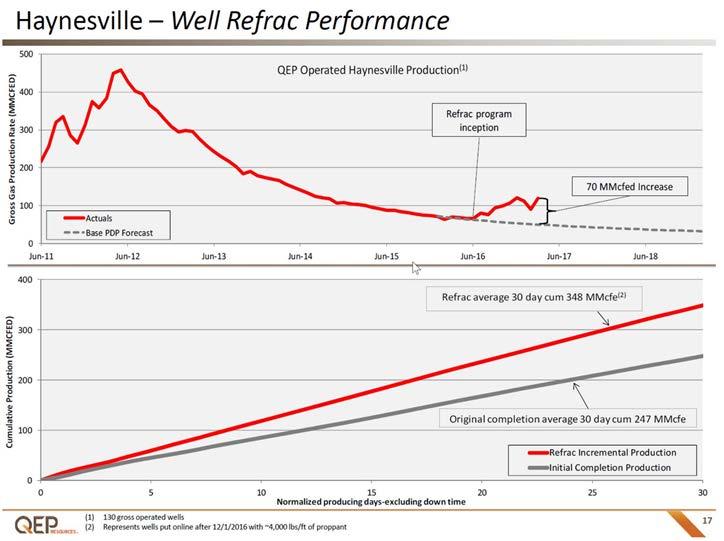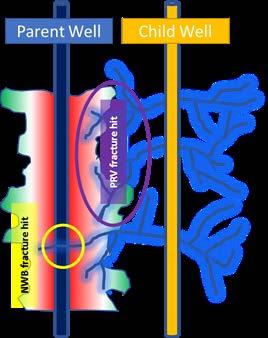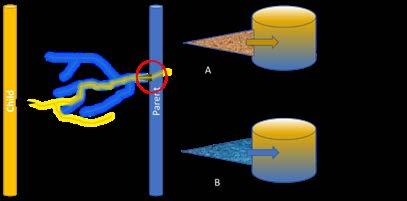
10 minute read
Midspread

Mike Cherry
Advertisement
CEO of Matterhorn Energy
Refracs

It is a fact that over 80% of the horizontal wells completed prior to 2012, in the foremost shale plays in North America, were grossly under-stimulated. Refrac results from wells of this vintage clearly show a large part of the stimulated reservoir volume that was believed to have been stimulated is indeed not contributing to the well’s production. How do you see that? By refracs on the earlier vintage’s best wells, that have since been re-stimulated, using today’s best practices and seeing results that equal or exceed the well’s initial performance and hold up as if you have drilled and completed a brand new well. The only way that could occur is by connecting new rock (matrix and fractures) that were not adequately stimulated, the first time.
Plays that are over-pressured, suffer from an additional deficit, in that, how the well was allowed to flow back after stimulation is as critical as the completion design itself. It is very clear using analytic software, operators that pulled their wells harder in attempt to get higher IPs have indeed permanently damaged the performance of their wells. Thus, one can conclude that conservative choke management is absolutely mandatory to maximize the performance and long-term recovery from over-pressured reservoirs, such as the Eagleford and Haynesville, to name a few of the big ones, with significant data to analyze. The bottom line is to achieve the best performing wells that greatly exceed their offsets in similar geologic
environments, one must ensure that all productive pay is adequately stimulated and connected with the natural fracture systems that exist in addition to the matrix itself. Biwing conventional fracs that are pumped with cross linked gels do not adequately connect the matrix and the fracture system to maximize the stimulated volume. To accomplish a well-designed stimulation, one has to ensure that all pay within a stage is of “like-rock” to prevent the stimulation preferring to go more to the area of greatest permeability, than to the rock with lesser permeability that truly benefits the most from the frac stimulation. This can be accomplished by combining like-rock within stages and utilizing a limited entry approach


to perforating. Thus, when best practices have not been adhered to, the resultant wells have been found to be excellent refrac candidates that will truly result in performance equal to or greater than the original completions. Thus, utilizing big data analytics, operators can determine how their well performance stacks up to the competition and at the same time discerning what are the best completion designs that have resulted in the best performance in the plays you are involved. This also provides a tool to analyze who might be the best take over wherein frac designs were not optimized and resulted in wells grossly under-stimulated.

Most horizontal refracs have been done on 4000-5000 ft laterals. The two most common methods have been 1) biovert diversion and 2) running 3.5” casing/liners inside wells with 5-1/2” production casing strings. Biovert diversion has not been as effective but the only choice in existing wells with production casing smaller than 5-1/2” and has mostly been done using more conventional, hybrid style of fracs. The best alternative with the best results have been running the 3.5” string and enabling the operator to completely do a limited entry perforating method with a more effective frac design as I described herein to better connect the matrix and natural fracture system.
I recognize there is limited public data on refracs but there have been operators that have been very successful in re-stimulating horizontal wells such as QEP and there are numerous others we are familiar with that have been equally or more successful than even this article displays, that have chosen to not share their data. I can assure you the new refracs have shown to add new reserves and greatly outperform the original wells, as exhibited by QEP.
I have not spoken with anyone from QEP and my comments in this article are not from any information I have received from the company or its employees, but merely observations based upon new refracs with which I am familiar. Congratulations to QEP for great work and your willingness to share your results with the industry! You are to be commended for going beyond what the industry deems an acceptable, industry-standard approach to completion design.
Piyush Pankaj
Principal Reservoir Engineer-Team Leader, Software Integrated Solutions (SIS), Schlumberger

Decoding Positives or Negatives of Fracture-Hits: A Geomechanical Investigation of Fracture-Hits and its Implications for Well Productivity
Introduction
One of the most commonly discussed topics in the context of unconventional reservoirs is the fracture- hits occurring in horizontal wells. The discussion groups are divided into arguments against claiming either positive or negative, and sometimes neutral, consequences of these fracture- hits to productivity of the wellbore. The effect can be as minimal as observing a temporary pressure spike in a well while hydraulically fracturing the nearby well to as drastic as observing proppants flowback, wellbore collapse.
In general, a fracture hit can be defined as any perturbation observed in the wellbore immediately due to a fracturing operation in the offset well. The perturbation may be in the form of change in production, change in pressures, or change in wellbore (cased or open hole) conditions. We classify fracture hits into near-wellbore fracture hits (NWB fracture hits) and producing rock volume fracture hits(PRV fracture hits) (Fig. 1).

Fig. 1—Defining NWB and PRV fracture hits.
The fracture-hit can further be subdivided into multiple forms of fracture hits: • A fluid fracture hit is a fracture hit that has been caused by clean fracturing fluid only influencing the offset wellbore and no proppants traversed in the fracture face. This may have long-term impact on wellbore productivity; the impact is generally negative. • A propped fracture hit is a fracture-hit that has been caused by the proppant laden fracturing fluid influencing the offset wellbore. This may have longterm impact on wellbore productivity; the impact is generally positive.

• A pressurized fracture hit is a fracture hit that is due to pressure transmission and includes aggravated forms of fluid and proppant fracture hits. However, this does not have a sustained long-term impact on well productivity.
Methodology The fracture hits may be caused by various conditions of well completion, reservoir properties, or the combination of both. The following conditions are evaluated for estimating the degree of fracture hits: • Depletion around the parent wellbore and stress change • Impact of perforation efficiency and open clusters in the child wellbore. • Impact of treatment design on the child wellbore • Impact of well spacing. The closer the wellbore, the higher is the risk of a fracture hit. An advanced geomechanical modeling workflow has been developed to understand fracture hits and their impact. The modeling workflow includes a series of steps as shown in Fig. 2. The workflow is derived from the workflow presented by Pankaj et al. (2016).
Effect of Fracture Hits on Well Productivity As NWB fracture hits occur, the hydraulic fracture carrying fluid at high pressure and proppants would not only touch the parent wellbore but also bears the risk of carrying sand into the wellbore by connecting through the pre-existing hydraulic fractures (Fig. 3). This would necessitate wellbore cleanout and coiled tubing well intervention in the parent wellbore. Additionally, the hydraulic washout of a parent well’s near-wellbore proppants poses the threat of losing connected surface area that was contributing to the productive volume for the parent wellbore. This would theoretically cause a drop in the parent well productivity and hence would constitute a “negative” fracture hit from the production perspective. However, if the proppants from the child well’s hydraulic fracture imitates connection to the unpropped sections of the hydraulic fracture system, the parent well may suddenly see an incremental productive surface area coming in from the new child well’s fracture system. This condition may result in increasing the production from the parent wellbore, which would cause this well to be put in the “positive” fracture-hit category (Fig. 4).
Parent
Child

Fig. 3—NWB fracture-hit

Ratio of parent well fracture geometry propped with sand = 35%
Parent
Conclusions
Fig. 5: Left, parent well fracture geometry with proppant distribution. Right, parent and child well fracture grid with proppant distribution.
Fracture hits can have positive, neutral, or negative impacts on productivity of the parent wellbore. The nature of the production result depends largely on the factors such as increase in effective drainage volume as fractures overlap, type of overlap (fluid or propped), and degree of interference between the wells as they compete to produce from the same rock, Fracture hits have been typically considered as a problem when planning the well completion of wells in unconventional reservoirs. Operators have been aggressive in extracting the maximum oil and gas out of the reservoir and wells are placed close together, resulting in continuous fracture hits being observed in multiple reservoir basins. However, predictions of production response to fracture hits have been unreliable. The study presented provides a streamlined methodology to consistently describe the cause and effect relationship of fracture hits. Applying this methodology, operators can improve their well planning by accounting for the positive or negative impacts of the fracture hits.
Case 2: Negative Fracture Hit: In this case, the parent well has more than half of the fracture geometry propped with sand (~56%), and the fracture hit from the child well improves the surface area, when the child well is included in the simulation, the production drops by 17%. Therefore, considering production potential, the Parent fracture hit that had allowed bigger drainage for the parent wellbore did not help to improve production because the child well competed with the existing production drainage volume of the parent wellbore. As a result of the added productive fracture surface area with proppant, the resulting fracture hit would seem intuitively to have positive impact on production. However, because both child well and parent wells are producing, the positive effect of added surface area is not realized fully in the production response because both the wells start to compete for the same rock volume. Therefore, the net effect of production for the parent well due to the fracture hit becomes a negative impact in this scenario. Hence, in this case, the fracture hit can be considered to have a negative fracture hit.
Fig. 4—PRV fracture hit
Case: Positive Fracture Hit: In this case considered with a different treatment design on the parent wellbore, the hydraulic fracture generated had only over one third of the geometry propped with sand (~35%) and the fracture-hit from the child well improves the propped surface area. When the child well is not considered in production, the parent well shows and increase in production of over 100% (Fig. 7), but when the child well is included in the simulation, the production of the parent well is around 11% higher than the parent well’s production without the fracture hit. Therefore, considering production potential, the fracture hit can be seen as to create a positive impact in production. Positive fracture hit can also occur when exixitng nonproductive cluster from the parent well is intercepted by a proppant laden fracture front from the child well. This would make the non-producing perforation cluster access the nearby reservoir rock throught the supplemental hydraulic fractures from the child well.
Child Child Child
Parent
Parent
Parent

Fig. 6- Pressure depletion at 1 year with the three scenarios.








